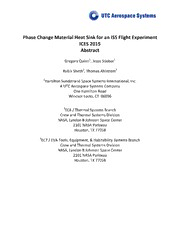
NASA Technical Reports Server (NTRS) 20140016955: Phase Change Material Heat Sink for an ISS Flight Experiment PDF
Preview NASA Technical Reports Server (NTRS) 20140016955: Phase Change Material Heat Sink for an ISS Flight Experiment
Phase Change Material Heat Sink for an ISS Flight Experiment ICES 2015 Abstract Gregory Quinn1, Jesse Stieber1 Rubik Sheth2, Thomas Ahlstrom3 1Hamilton Sundstrand Space Systems International, Inc. A UTC Aerospace Systems Company One Hamilton Road Windsor Locks, CT 06096 2EC6 / Thermal Systems Branch Crew and Thermal Systems Division NASA, Lyndon B Johnson Space Center 2101 NASA Parkway Houston, TX 77058 3EC7 / EVA Tools, Equipment, & Habitability Systems Branch Crew and Thermal Systems Division NASA, Lyndon B Johnson Space Center 2101 NASA Parkway Houston, TX 77058 Abstract A flight experiment is being constructed to utilize the persistent microgravity environment of the International Space Station (ISS) to prove out operation of a microgravity compatible phase change material (PCM) heat sink. A PCM heat sink can help to reduce the overall mass and volume of future exploration spacecraft thermal control systems (TCS). The program is characterizing a new PCM heat sink that incorporates a novel phase management approach to prevent high pressures and structural deformation that often occur with PCM heat sinks undergoing cyclic operation in microgravity. The PCM unit was made using brazed aluminum construction with paraffin wax as the fusible material. It is designed to be installed into a propylene glycol and water cooling loop, with scaling consistent with the conceptual designs for the Orion Multipurpose Crew Vehicle. This paper reports on the construction of the PCM heat sink and on initial ground test results conducted at UTC Aerospace Systems prior to delivery to NASA. The prototype will be tested later on the ground and in orbit via a self‐contained experiment package developed by NASA Johnson Space Center to operate in an ISS EXPRESS rack. NOTE: An updated abstract with final build data and test data (due early spring 2015) will be included in the paper. 2
